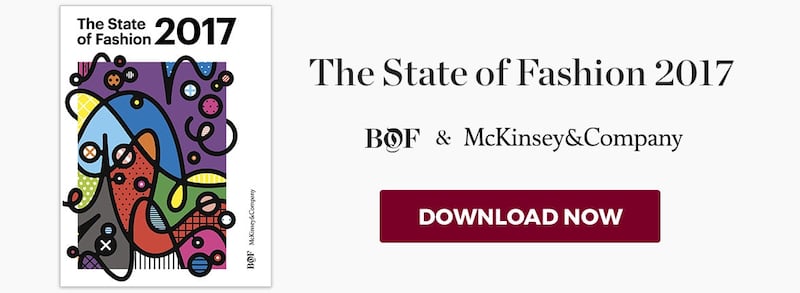
Discover the latest version of The State of Fashion and view all previous editions of the report here — our annual in-depth report on the future of the fashion, beauty and luxury industries, produced in partnership with McKinsey & Company.
LONDON, United Kingdom — The past year has been a tough one for the global fashion industry. With 2016 revenue growth forecast at just 2 – 2.5 percent, the industry generated its worst operating profit since the financial crisis in 2009, while profit margins (before tax) stagnated at just under 10 percent.
Luxury and mid-range fashion companies have been hit particularly hard with a growth rate of just 0.5 – 1 percent, well below the industry average. But, according to the report, the development is looking more promising for 2017. In terms of sales the analysis shows that the fashion industry will grow 2.5 – 3.5 percent in 2017 on average. While this represents a slight recovery, it is not yet back at the historical 5.5 percent annual growth that the fashion industry has enjoyed over the past decade: until 2015, the industry’s growth consistently outstripped global GDP growth by several percentage points.
These are the main findings in the inaugural “The State of Fashion 2017 Report”, which analyses the performance of the global fashion industry and provides a forecast for 2017. BoF and McKinsey & Company analysed 450 fashion companies and surveyed 140 industry experts and company executives. The full results will be presented at VOICES, BoF’s new annual gathering for big thinkers, in Oxfordshire, United Kingdom, 1 – 3 December, and are available to download here.
Optimistic about 2017
“We expect the fashion industry to recover in 2017. Many fashion companies have already undertaken significant restructuring exercises, and are now primed to capture the benefits,” says Imran Amed, founder and chief executive officer of BoF.
The slight recovery stems from a range of sources. First, macroeconomic indicators, including global GDP growth forecasts which are highly correlated with fashion and consumer sentiment, are expected to improve next year. Second, the investment community expects improvements across the entire fashion industry, particularly driven by the behemoths within these segments, which are reorganising and divesting non-performing, non-core brands. This is confirmed by the industry executives surveyed for the report. Almost half of those interviewed expect 2017 to be better than 2016. “Uncertain,” “challenging,”, and “unstable” are the terms used most frequently to describe the fashion industry in 2016.
“The analysis suggests a general growth improvement for all segments except for discount in 2017. In particular, value and affordable luxury segments are likely to perform exceptionally well: with the value segment growing 3 – 4 percent and affordable luxury 3.5 – 4.5 percent,“ says Achim Berg, Senior Partner and expert for the fashion and luxury industry at McKinsey. Both segments, value and affordable luxury fashion, benefit through shifts from other segments, as more customers downtrade from luxury to affordable luxury and uptrade from discount to value.
Product categories will grow in 2017 in line with the overall industry, increasing one or two percentage points from 2016. The sports goods category will be the category winner next year with an increase by 6.5 – 7.5 percent, outstripping all other categories. It already experienced above-average growth of 8 – 8.5 percent in 2016.
Ten key trends for 2017
The report also lays out 10 key trends the fashion industry should look out for next year. The first set of trends are around global economy, including how fashion will respond to intensifying volatility, continued challenges in China and increased importance of urban centres.
The second are around the consumer – who is growing ever better informed and demanding, and whose demographic profile is shifting.
Lastly, the report predicts several key changes to the “fashion system” next year. “There are historic changes happening in the fashion cycle, and at the same time significant technological advancements that are changing the industry. In addition, we expect there will be some kind of a shake-up in ownership of fashion companies as larger players restructure and industry outsiders become more active in the fashion space,” says Leonie Brantberg, Associate Partner at McKinsey and co-author of the study.
Click here to download The State of Fashion 2017, The Business of Fashion and McKinsey & Company’s in-depth report on the global fashion industry in 2017, focusing on the themes, issues and opportunities impacting the sector and its performance.



